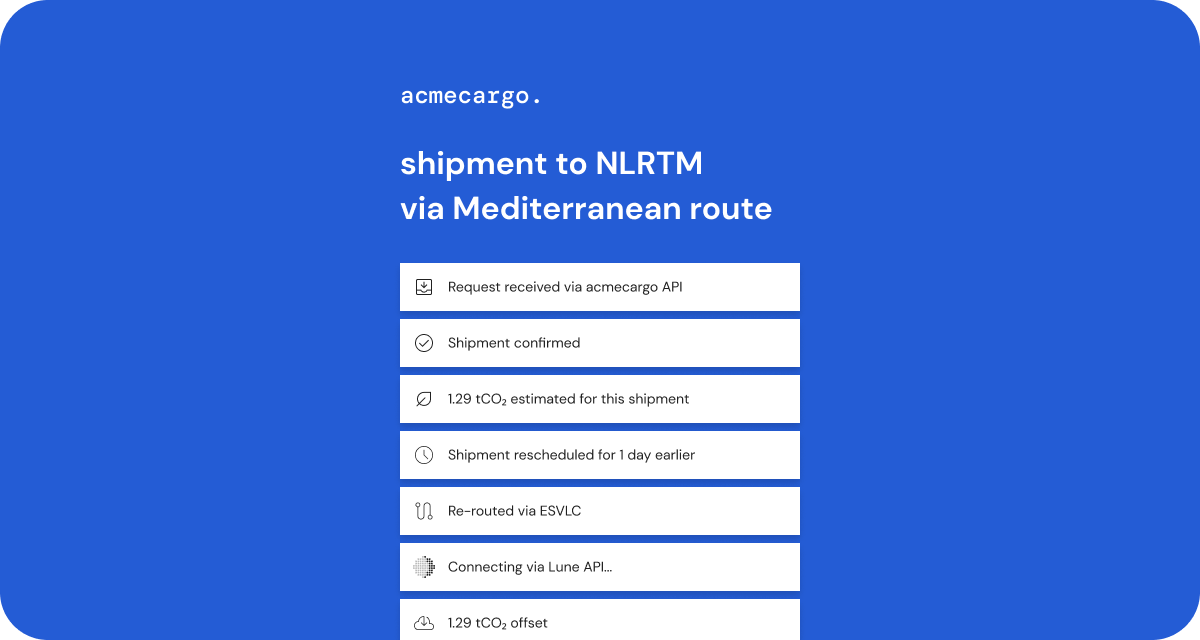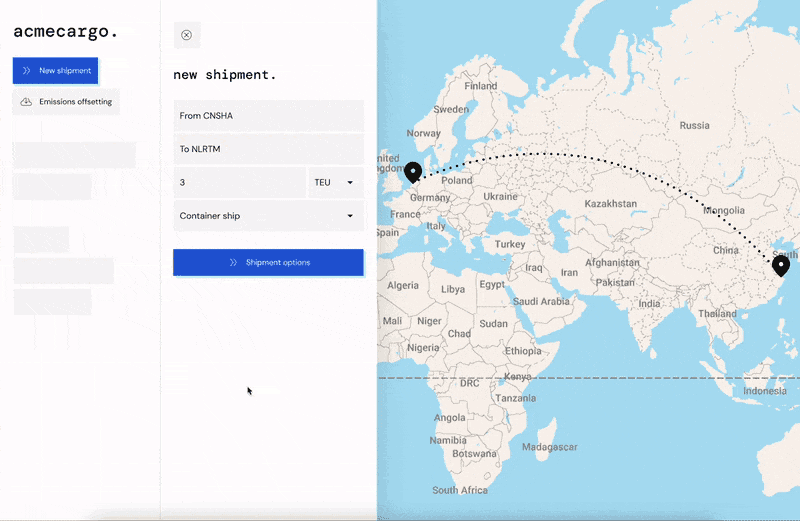

Recently it’s been a time of transformation for the logistics sector.
The Covid-19 pandemic brought the supply chain to almost a standstill in 2020-21, with most forms of travel restricted and quarantines for vessels and cargo. And it’s remained an unpredictable climate for logistics since then, with supply chain disruptions hitting the press on the regular. There’s been Brexit, the Russia-Ukraine war, the Ever Given ship blocking the Suez Canal, extreme weather events like the heatwave and flooding in India and Pakistan this year, and more.
But the industry has responded with innovation and transformation – particularly with ways to make logistics processes more reliable and efficient, and improve transparency for the businesses reliant on them.
At the heart of this transformation has been two trends: digital and sustainable logistics solutions.
1. The digital transformation in logistics
Spreadsheets are a thing of the distant past.
There have always been times of pressure in the logistics calendar – holidays like Golden Week, Black Friday, and Christmas cause huge spikes in demand, for instance.
But the uncertainty and unpredictability of those recent events and disruptions in the supply chain has made them much more difficult to manage – identifying vulnerabilities in the logistics sector, from port congestions to bottlenecks and more. That’s likely to continue for the foreseeable, especially given that extreme weather events caused by climate change will become more and more common.
With success being measured by the speed and accuracy of deliveries, logistics companies are doing everything they can to streamline operations and reduce the risks of disruptions – which means becoming agile.
A key issue has been a lack of information and transparency across the supply chain, which makes it difficult for players in the supply chain to react when disruptions occur.
The US Government highlighted this when launching their Freight Logistics Optimization Works (FLOW) programme to support data exchange across the supply chain:
It’s clear that logistics companies need to become more agile – and that’s a big reason behind why digital transformation has become top of the agenda in 2022.
So what does digital transformation look like in logistics?
Well, it means every element of logistics being digitised, including:
- Unified systems: historically logistics companies have used many disparate processes, systems, spreadsheets to make up their full offering – especially where there are multimodal journeys (which are becoming the norm to reduce the risk of e.g. port congestion). Bringing these together to create a single, unified, digital platform is a key part of digitisation in logistics, creating seamless processes.
- Visibility: disparate and complex processes have meant a lack of transparency about the behind-the-scenes of deliveries. Digitisation enables end-to-end visibility and real-time monitoring and management – enabling risks to be identified more quickly, inefficiencies to be spotted and optimised, and customers to be kept up-to-date with real-time information.
- Forecasting: uncertainty has been a huge issue, and logistics management software enables companies to forecast inventory and deliveries to improve the predictability of busy periods. Unforeseen events will still occur, but overall management is much improved.
- Optimising routes and modes: visibility of the availability and timing of different routes and modes of transport enables deliveries to be optimised for speed and efficiency.
- Technologies: drones for last-mile delivery, robots automating warehouse processes, 3D printing packaging – there’s an abundance of technology which could be implemented in logistics to improve efficiency, both in warehouses and on-the-ground deliveries.
And that just scratches the surface.
There’s more to come, and there’s value to be made – research by the World Economic Forum found that digitisation in logistics could provide $1.5 trillion in value by 2025.
2. Sustainable logistics solutions
As we’ve mentioned, disruption in the supply chain is already being caused by rising temperatures and extreme weather events. It’s evident that climate change will affect logistics immensely, and companies need to adapt now.
On top of that, pressure on businesses to report on and reduce environmental impact is increasing, with new legal regulations on climate disclosure coming into force and more and more investors requiring ESG information too. These are affecting all companies, but for logistics companies your business customers will also be coming to you for needing information for their own Scope 3 emissions reporting and looking for opportunities to cut the emissions from their goods transportation.
For logistics companies, then, that pressure for reporting is coming from all directions.
Plus, at the same time, it’s also becoming obvious that sustainability is good for business too – the WeForum report 'Net-Zero Challenge: The supply chain opportunity' finds that 40% of supply chain emissions could be cut at very low costs, and that given that consumers will typically pay premiums of around 40% for sustainable products and services, there could be very high return on this investment.
So as well as pressure, there’s growing commercial incentive to act. Consumers are demanding sustainable solutions and the companies that can offer them are gaining market share and loyal customers. That means that the retail and ecommerce companies that make up the bulk of the customer base for logistics organisations, are moving to suppliers that can provide truly sustainable solutions – including in logistics.
Subscribe for the latest insights into driving climate positivity
Companies like Forto, AGX, and Budbee are already seizing the opportunity to implement climate-positive solutions, and seeing positive results for both planet and profitability.
Every company should be working to improve their own environmental impact – measuring and reducing their own carbon emissions and offsetting any unavoidable emissions using high-quality offsets. And there are many potential solutions out there for logistics, from alternative fuels to electric vehicles to last mile deliveries by bike (or drone, even!)
But, reducing emissions in an individual company can only go so far. Many industries also have opportunities to create exponential climate impact through the product or service offered: including logistics.
So, what could this exponential climate impact look like in logistics?
- Carbon emissions visibility: calculating the emissions of a delivery and making it visible within a logistics platform improves transparency around climate impact, educating your entire customer base of merchants about the impact of transport on the environment, and helping them to identify areas of high emissions that they could look to reduce – creating a network of businesses all working to make environmental improvements. Even better would be benchmarking this data across your entire customer base e.g. showing a customer that their deliveries are in the 5% highest-emitting because they’re defaulting to using air freight might be the nudge they need to explore other options.
- Low carbon route optimisation: embedding emissions calculations into your platform also brings the opportunity to offer a ‘green’ or ‘low carbon’ route to customers booking your services – showing the route or modes of transport which offer the lowest emissions delivery.
- Integrated offsetting: you could also offer customers the option to automatically offset the emissions of a product journey – or commit to offsetting all or part of those emissions yourself as part of your own sustainability strategy. A note on this: always ensure the offset projects you offer are high-quality, so that real impact is made.
Here’s an example of what these features could look like within a logistics platform:

We’ve written about these opportunities in more detail on our previous blog: How the logistics sector could tackle the climate crisis.
You might notice that there are also clear links between these two trends:
- End-to-end visibility: making transport emissions visible is the key to start engaging logistics customers with understanding and reducing their environmental impact – and the new unified and digital logistics platforms of today are making that possible.
- Efficiency: that improved visibility which digital solutions bring enable logistics companies to improve processes, streamline operations, and reduce the risk of supply chain disruptions. All of which represent efficiencies which also hold the potential to minimise emissions in the sector – eliminating unnecessary journeys, choosing more efficient routes, reducing delays and idle vehicles, and so on.
Digitisation and sustainability in logistics: the two go hand-in-hand in transforming the logistics industry for a more efficient, less disrupted, and greener future.
Need to get senior leaders to prioritise sustainable logistics solutions?
Getting internal buy-in from senior leaders and decision makers to make sustainability a commercial priority isn't always easy. We'd recommend putting together a business case for a sustainable logistics proposition, aligned to your company's commercial goals and priorities. And to help you get started, we've put together a slide deck template for pitching the business case to your decision makers.
To access the slide deck template, fill in this form.
![The business case for sustainable logistics at [insert company name]](/_next/image?url=https%3A%2F%2Fimages.prismic.io%2Fluneco%2Ff8c647dc-047a-43ed-a625-5a5088d2bb51_business-case-logistics-header-min.png%3Fauto%3Dcompress%2Cformat&w=3840&q=75)
Readers also liked
Readers also liked

Subscribe for emissions intelligence insights
Get the latest updates in the world of carbon tracking, accounting, reporting, and offsetting direct to your inbox.


